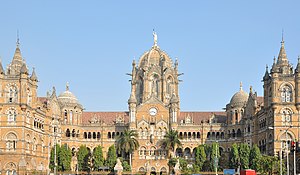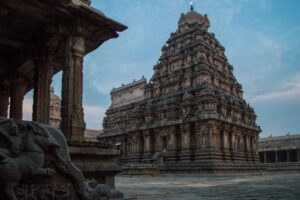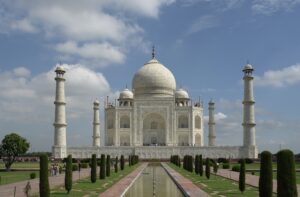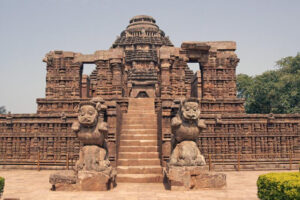India is famous for its civilized and diverse cultural history with several races and religions. India’s architectural background is rich and can be easily picturized through its monuments. There are varied ranges of architecture that help build some extraordinary buildings. India combines ethnic, racial, historical, geographical, climatic, and linguistic diversities. These have bloomed out the varied architectural styles to represent their uniqueness. This is just like the other form of art; the architecture of India is helping to present the ability to construct out of the box. Let’s delve into the type of architecture in India and understand its uniqueness in the form of architectural ability.
#1. Temple Architecture
 Since ancient times, temple architecture has become a symbol for India to gain people’s attention. This includes the inner sanctum, the womb chamber of Garbha Griha, and the bare cell where the image of the deity should be housed. This type of architecture is synchronized through ancient Vedic, which emphasizes harmony, symmetry, and balance, called Vastu Shastra, to uplift the positive aura.
Since ancient times, temple architecture has become a symbol for India to gain people’s attention. This includes the inner sanctum, the womb chamber of Garbha Griha, and the bare cell where the image of the deity should be housed. This type of architecture is synchronized through ancient Vedic, which emphasizes harmony, symmetry, and balance, called Vastu Shastra, to uplift the positive aura.
Sun temple is one of the finest examples of temple architecture. The design includes 24 carved wheels on the north and south sides with 3m diameter, and this motif refers to the cycle of seasons and months. Isn’t that amazing? A 13-century carved temple still holds its position because of its accurate scale, conception, and proportion of architectural design.
#2. Indo-Saracenic Revival Architecture
 This is a form of fusion of Indo-Islamic and Indian cultural architecture that signifies the style of Gothic revival from Victorian Britain and Neoclassical styles. British architects mainly adopted this style in the 19th century. Think of it like this: the tomb structure adopted by Islamic architects, adding traditional elements from Indian architects and involvement of gargoyles and allegorical grotesques symbolizes the Gothic style, and this is how the involvement of different cultures developed Indo-Saracenic revival architecture.
This is a form of fusion of Indo-Islamic and Indian cultural architecture that signifies the style of Gothic revival from Victorian Britain and Neoclassical styles. British architects mainly adopted this style in the 19th century. Think of it like this: the tomb structure adopted by Islamic architects, adding traditional elements from Indian architects and involvement of gargoyles and allegorical grotesques symbolizes the Gothic style, and this is how the involvement of different cultures developed Indo-Saracenic revival architecture.
For example, the Chhatrapati Shivaji Terminus of Mumbai (listed under UNESCO World Heritage 2004) is a perfect example of Indo-Saracenic revival architecture. Surreal architecture involves marvelous features like turrets, stone domes, and pointed arches of Indian design with facades of gargoyles from Gothic characteristics.
#3. Dravidian Architecture

You can say this is one of the stunning forms of architecture that emerged in the soil of the South Indian subcontinent thousands of years ago. This depicts the pyramid architecture form named Kovils. The style of the architecture is based on Agamas. Agamas are Tamil and Sanskrit sculptures that signify the temple construction and creation method, including meditative practices, philosophical doctrines, yogas, and desires. Kovils are constructed over carved stones, and their design resembles the statues of deities, dancers, warriors, and kings.
Brihadeshwara Temple (a tribute to lord Nataraja) is one of the most magnificent, embezzling Dravidian architecture’s legacy. This temple does not cast any shadow on the ground when the sun is at its pinnacle, which defines its divine sanctity and spiritual significance.
#4. Mughal Architecture
 A combination of Islamic, Indian, and Persian styles is called Mughal architecture. Massive halls, vaulted gateways, ornamentation, marble, red sandstone, slender minarets, and domes are some features added to the Mughal architecture. Mughal architecture is also known for its beautiful gardens, a vital part of the overall design.
A combination of Islamic, Indian, and Persian styles is called Mughal architecture. Massive halls, vaulted gateways, ornamentation, marble, red sandstone, slender minarets, and domes are some features added to the Mughal architecture. Mughal architecture is also known for its beautiful gardens, a vital part of the overall design.
Everybody knows the Red Fort and the Taj Mahal, significant examples of the Mughals’ presence in architectural design. Taj Mahal is, without a doubt, the most famous architectural beauty brought up in India. The structure is made of white marble with precious stones inlaid in intricate designs, and the gardens surrounding the mausoleum are a testament to the Mughal’s love for nature. Another famous example of Mughal architecture is the Red Fort in Delhi, a UNESCO World Heritage site. The fort features impressive walls, gates, beautiful pavilions, gardens, and water channels.
#5. Sikh Architecture
 As the name suggests, this is a fond design in the Punjab zone. The evolution of the Mughal architecture style includes the tomb-like structure at the top of the building, known as chhatris (kiosks). Sikh architecture is a style that has evolved from the Mughal architecture. It is characterized by its simplicity and functionality, focusing on creating a sacred space that is open and accessible to all. Golden Temple is the one that is majorly famous for its Sikh architecture. It is a mixture of Hindu-Rajput and Indo-Islamic contradiction. The architecture symbolizes the quality around the sanctum and the pool.
As the name suggests, this is a fond design in the Punjab zone. The evolution of the Mughal architecture style includes the tomb-like structure at the top of the building, known as chhatris (kiosks). Sikh architecture is a style that has evolved from the Mughal architecture. It is characterized by its simplicity and functionality, focusing on creating a sacred space that is open and accessible to all. Golden Temple is the one that is majorly famous for its Sikh architecture. It is a mixture of Hindu-Rajput and Indo-Islamic contradiction. The architecture symbolizes the quality around the sanctum and the pool.
#6. Indian Vernacular Architecture
 This type of structure is famous all around the world because of its traditional method to build the building. Not in the cities, but people from the mountains prefer to construct a home made of rocks, ashlar, and stone to construct their beautiful buildings. The meaning of Vernacular instincts with local culture and climate and building by dwelling with local materials and resources. Some of the beautiful and enchanting beauty of Indian vernacular architecture can be seen in Rajasthan, as the Havelis reflect India’s cultural heritage, such as Aranya Farmstay Resort in Sasan Gir. The diverse and rich culture perfectly blends with this type of architectural style.
This type of structure is famous all around the world because of its traditional method to build the building. Not in the cities, but people from the mountains prefer to construct a home made of rocks, ashlar, and stone to construct their beautiful buildings. The meaning of Vernacular instincts with local culture and climate and building by dwelling with local materials and resources. Some of the beautiful and enchanting beauty of Indian vernacular architecture can be seen in Rajasthan, as the Havelis reflect India’s cultural heritage, such as Aranya Farmstay Resort in Sasan Gir. The diverse and rich culture perfectly blends with this type of architectural style.
#7. Cave Architecture
 Cave architecture is also known as Rock-cut architecture. This is a practice where the structure of the building is majorly constructed out of the rock and gives them natural beauty. These towers are made of one rock; some of the finest buildings are Karla Caves, Bhaja Caves, Ajanta Caves, and Kanheri Caves. Being the oldest and most primitive architectural style in India, this style has served many purposes, such as religious, residential, commercial, etc. The most famous examples of cave architecture in India are the Ajanta and Ellora caves in Maharashtra also a UNESCO World Heritage site. Thirty rocks cover Ajanta caves and the Buddhist cave monuments were built between the 2nd century BCE and 600 CE. These caves are famous for their exquisite frescoes and sculptures, which depict stories from the Jataka tales and the life of the Buddha. The caves also have chaitya halls (prayer halls) and viharas (monasteries).
Cave architecture is also known as Rock-cut architecture. This is a practice where the structure of the building is majorly constructed out of the rock and gives them natural beauty. These towers are made of one rock; some of the finest buildings are Karla Caves, Bhaja Caves, Ajanta Caves, and Kanheri Caves. Being the oldest and most primitive architectural style in India, this style has served many purposes, such as religious, residential, commercial, etc. The most famous examples of cave architecture in India are the Ajanta and Ellora caves in Maharashtra also a UNESCO World Heritage site. Thirty rocks cover Ajanta caves and the Buddhist cave monuments were built between the 2nd century BCE and 600 CE. These caves are famous for their exquisite frescoes and sculptures, which depict stories from the Jataka tales and the life of the Buddha. The caves also have chaitya halls (prayer halls) and viharas (monasteries).
#8. Kalinga Architecture
 This type of structure is mainly found in Odisha in the Northern parts of Andhra Pradesh. Kalinga architecture has two parts: A tower and a hall with lavishly sculpted architectural motifs A profusion of images or figures It is highly known for its rich decorative design and use of Indian materials such as stone and wood. Architects prefer to instill life into the stones through the craft in this architecture.
This type of structure is mainly found in Odisha in the Northern parts of Andhra Pradesh. Kalinga architecture has two parts: A tower and a hall with lavishly sculpted architectural motifs A profusion of images or figures It is highly known for its rich decorative design and use of Indian materials such as stone and wood. Architects prefer to instill life into the stones through the craft in this architecture.
Konark sun temple is the finest architecture that exhibits Kalinga architecture. It is mounted on 12 pairs of wheels, including seven mighty stone horses. The design is built in a way that the first ray of the sun illuminates the main entrance. This is the beauty of architecture to sanctify the crafting. Moreover, it includes a zig-zag pattern, miniature decorative structures, wall decorations engraved with handmade designs, etc.
#9. Vesara Architecture
 Vesara’s architectural style evolved in the medieval centuries. It is a combination of Dravida and Nagara types of architecture. Vesara is a Sanskrit word which means Vishra (an area to walk for a long time). Based on the meaning, this type of building includes a location for a long walk. It emerged during the 6th to 8th centuries and is characterized by a blend of rock-cut and structural elements, intricate carvings, and ornate sculptures. The Vesara style is most commonly found in temples and other religious buildings, and it has significantly influenced the development of Indian architecture over the centuries. Examples of Vesara Architecture include Kailashnath Tmeple, Ellora, Virupaksha, and Ladkhan Temple.
Vesara’s architectural style evolved in the medieval centuries. It is a combination of Dravida and Nagara types of architecture. Vesara is a Sanskrit word which means Vishra (an area to walk for a long time). Based on the meaning, this type of building includes a location for a long walk. It emerged during the 6th to 8th centuries and is characterized by a blend of rock-cut and structural elements, intricate carvings, and ornate sculptures. The Vesara style is most commonly found in temples and other religious buildings, and it has significantly influenced the development of Indian architecture over the centuries. Examples of Vesara Architecture include Kailashnath Tmeple, Ellora, Virupaksha, and Ladkhan Temple.
#10. Modern Indian Architecture
 Nowadays, builders and people have both started to prefer sustainable, innovative, and creative buildings. This is easy to work effectively and offers safety as well. The existence of modern architecture has prevailed in 1947. This type of construction includes domes, curved lines, and three-dimensional structures, and some include the thoughts of old-age architectural style but a new hinch of ideas. The idea of this modern style is to offer sustainability and longevity to the buildings to facilitate the technological transformations that are happening. There are numerous examples of modern Indian architecture, but some of them include the Lotus Temple, the Bamboo Symphony by Manasaram Architects, and many more.
Nowadays, builders and people have both started to prefer sustainable, innovative, and creative buildings. This is easy to work effectively and offers safety as well. The existence of modern architecture has prevailed in 1947. This type of construction includes domes, curved lines, and three-dimensional structures, and some include the thoughts of old-age architectural style but a new hinch of ideas. The idea of this modern style is to offer sustainability and longevity to the buildings to facilitate the technological transformations that are happening. There are numerous examples of modern Indian architecture, but some of them include the Lotus Temple, the Bamboo Symphony by Manasaram Architects, and many more.
Final Caveat
There are many architectural styles in India, and they have continuously evolved. Based on the demand of the building and the style that anyone wanted to choose, catering to the changes is essential. A combination of ancient and modern architectural styles helps to build innovative ideas. Because of the Indian cultural and heritage designs, some sites come under UNESCO World Heritage Sites.

0 Comments